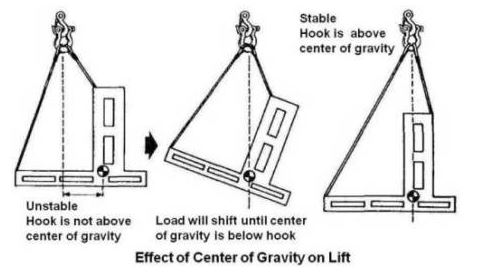  
Center of Gravity
When lifting an object with one or more slings,
it is important to have the crane hook placed directly above
the center of gravity of the object being lifted.
If it is not, the object will be tilted when lifted.
For a uniform object, it is fairly easy to determine the center of gravity by
simply finding the center of the object.
For many items this is not possible.

For a stable lift, the crane hook must be directly above the center of gravity.
This can be accomplished by adjusting the attachment points to the load, or
by using slings of unequal length.
A turnbuckle may be used to achieve fine adjustment of the length of one of the slings.
The length of a sling should never be adjusted by tying knots in the sling or
by wrapping the sling multiple times around the hook or other attachment point.
Do not lift items when the center of gravity is not directly below the hook.
This may involve adjusting the rigging several times before doing the lift.
Load Stability
The lifting points must also be above the center of gravity for the load to be stable.
An example of this is when lifting a pallet with a large object on it.
For it to be stable the center of gravity must be inside of the angle formed by the lifting slings.
It is generally preferable to lift items from a point as close to the top of the object as
is possible.
In general, when lifting a object, lift it a couple of inches first.
If the item is not level, adjust the slings to balance the load before doing the lift.
|